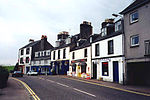Knapdale

Knapdale (Scottish Gaelic: Cnapadal, IPA: [ˈkɾaʰpət̪əl̪ˠ]) forms a rural district of Argyll and Bute in the Scottish Highlands, adjoining Kintyre to the south, and divided from the rest of Argyll to the north by the Crinan Canal. It includes two parishes, North Knapdale and South Knapdale. The area is bounded by sea to the east and west (Loch Fyne and the Sound of Jura respectively), whilst the sea loch of West Loch Tarbert almost completely cuts off the area from Kintyre to the south. The name is derived from two Gaelic elements: Cnap meaning hill and Dall meaning field. Knapdale gives its name to the Knapdale National Scenic Area, one of the forty national scenic areas in Scotland, which are defined so as to identify areas of exceptional scenery and to ensure their protection from inappropriate development. The designated area covers 32,832 hectares (81,130 acres) in total, of which 20,821 hectares (51,450 acres) is on land and 12,011 hectares (29,680 acres) is marine (i.e. below low tide level).
Excerpt from the Wikipedia article Knapdale (License: CC BY-SA 3.0, Authors, Images).Knapdale
Geographical coordinates (GPS) Address Nearby Places Show on map
Geographical coordinates (GPS)
| Latitude | Longitude |
|---|---|
| N 56.02 ° | E -5.52 ° |
Address
Argyll and Bute
Scotland, United Kingdom
Open on Google Maps










